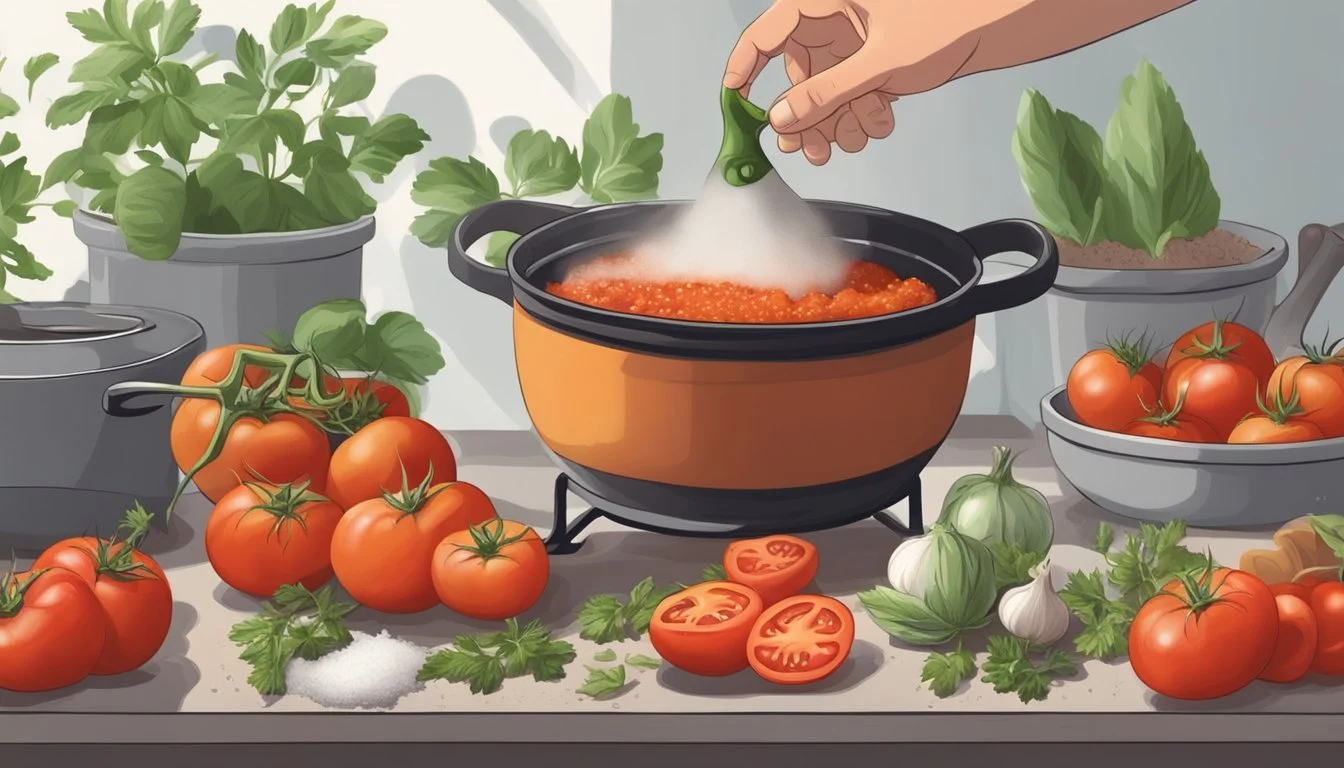Taming Overly Acidic Tomato Sauce
A Guide to Achieving Perfect Balance
Tomato sauce is a culinary staple enjoyed across countless cuisines globally for its rich flavor and versatility. However, a common issue faced by chefs and home cooks alike is managing the acidity that naturally occurs in tomatoes (What wine goes well with tomatoes?). This can lead to a sauce that is overly sharp on the palate, overshadowing the delicate blend of flavors one might aim for in a well-rounded dish. Balancing the acidity in tomato sauce is key to creating a harmonious flavor profile that complements the main ingredients rather than overwhelming them.
Addressing the acidity in tomato sauce involves a few strategic approaches. Sweetening agents, for instance, are often used to counteract acidity. While sugar is a popular choice, natural sweeteners like carrots and onions not only contribute to reducing sharpness but also add depth to the overall taste. Alternatively, fats such as olive oil can be introduced to mellow out the tartness while enhancing the sauce's texture and mouthfeel. Moreover, herbs and spices play a dual role by rounding out flavors and imparting complexity that can make acidity less pronounced.
In cases where culinary adjustments are needed to directly reduce acidity rather than just balance it, certain ingredients can be quite effective. Baking soda, a mild alkaline compound, interacts with acidic components in the tomato sauce, neutralizing some of the acid and making the sauce more palatable. While this remedy is efficient, caution is advised; excessive amounts might leave the sauce with an undesirable taste. Techniques around the preparation of tomatoes, such as peeling or deseeding, also influence the final acidity of the sauce and can be considered during the cooking process.
Understanding Acidity in Tomato Sauce
Tomato sauce's character is heavily influenced by acidity, which impacts everything from taste to digestibility. This section will elucidate the significance of pH levels in tomato sauce, how different tomato types contribute to acidity, and the typical acidic profile of tomato sauces.
The Role of pH in Sauce Acidity
pH levels are central to determining a sauce's acidity; the pH scale gauges how acidic or alkaline a substance is, with lower values being more acidic. Most tomato sauces fall between pH 3.5 to 4.7, which is slightly acidic. This level of acidity can often contribute to acid reflux for some individuals, and balancing the pH can make the sauce more palatable.
Comparing Types of Tomatoes
The type of tomato used can greatly affect the acidity of the sauce. For instance, San Marzano tomatoes are coveted for their richer flavor and lower acidity. In contrast, canned tomatoes and tomato puree may have higher acidity due to added citric acid to preserve freshness.
Ripe tomatoes: They tend to be less acidic than unripe ones.
Fresh tomatoes: Offer variability in acid levels depending on the variety and ripeness.
Canned tomatoes: Typically more acidic from concentration and preservatives.
Tomato Sauce Acidic Profile
The acidic profile of tomato sauce is not fixed and can vary based on factors like cooking time and additional ingredients. Long cooking times allow for acidity to mellow out, deepening the tomato flavor. San Marzano tomatoes are often preferred for a more balanced, less acidic sauce, while sauces made from other tomato types might need adjustments to tone down acidity.
Ingredients That Affect Sauce Acidity
When modifying the acidity of tomato sauce, it is essential to consider both natural and additive ingredients that can bring balance to the flavors.
Natural Acidity Modifiers
Fresh Ingredients:
Alkaline-rich vegetables: Carrots and onions naturally reduce acidity due to their alkaline composition and also add a slight sweetness to the sauce.
Potatoes: They can absorb some of the acid, but should be removed before serving.
Fresh herbs: Basil or oregano can enhance the sauce's complexity, making it seem less acidic.
Dairy Products:
Cream or butter: A dash of dairy can mellow out acidity, with the added benefit of creating a richer texture.
Cheese: Hard cheeses like Parmesan are sometimes stirred into the sauce, not only for flavor but also to cut acidity.
Common Acidity-Reducing Additives
Seasonings and Additives:
Sugar: A small amount can counteract acidity, but should be used sparingly to avoid over-sweetening.
Baking soda: A pinch can neutralize acidity through its alkaline properties.
Oils:
Olive oil: While not directly neutralizing acid, it coats the palate and can temper the perception of acidity.
Acids for Adjustment:
Lemon juice or vinegar: These might seem counterintuitive, but they can actually enhance certain flavors and make the sauce taste less tart.
Employing these ingredients allows for a reduction in the harshness of an overly acidic tomato sauce, resulting in a balanced and pleasant flavor profile.
Preparation Techniques for Balancing Acidity
Achieving the right balance of flavors in homemade tomato sauce hinges on skillfully managing acidity. This section outlines specific techniques to tame the sharpness of citric acid prevalent in tomatoes, creating a harmonious blend of sweetness and savory notes.
Adjusting Cooking Time
One effective method for balancing a sauce's acidity involves cooking time. Extending the simmering period allows acids within the sauce to mellow, resulting in more complex and rounded flavors. For example, a sauce that cooks for several hours will often have a less acidic taste than one cooked for a shorter duration.
Sautéing Aromatics
Aromatics such as onions or garlic, when gently sautéed, contribute a natural sweetness to the sauce. By sautéeing these ingredients until they're caramelized, not only does one build a deeper flavor foundation, but the innate sugar also helps counteract the acidity of tomatoes.
Integration of Sweeteners
Introducing sweeteners to tomato sauce can further assist in balancing acidity. Sweet flavors can be incorporated in various forms:
Natural Sweetness: Adding grated carrots or finely-chopped onions offers a subtle sweet undertone.
Direct Sweeteners: A small amount of sugar or honey may also be employed. However, it's important to use these sparingly to avoid overpowering the sauce with sweetness.
Creating a Less Acidic Tomato Sauce
When approaching the challenge of mitigating the acidity in tomato sauce, the cook can employ a variety of techniques, from balancing with sweetness to using dairy for a creamy texture. Additionally, incorporating various vegetables and herbs not only adds flavor complexity but can also help to create a more balanced sauce.
Balancing with Sweetness
The natural sugars found in certain ingredients can offset the sharpness of an acidic tomato base. Grated carrots, for instance, are not only high in sugar content but also contribute fiber and enhance the overall texture of the sauce. A touch of honey or sugar can also be added directly to the sauce, with the cook tasting and adjusting as necessary.
Utilizing Dairy for Smoothness
Dairy products such as butter, milk, or heavy cream offer a creamy consistency and can help mellow down the acidity in tomato sauce. The richness of cream complements the tangy profile of marinara sauce, while a dollop of butter lends a silky finish to homemade pasta sauce. It’s vital the cook stirs in these ingredients gradually and at the end of the cooking process to prevent curdling.
Incorporating Vegetables and Herbs
Adding a variety of vegetables, besides grated carrots, can provide not only nutrients but also help in cutting through the acidity. Bell peppers or onions introduce a natural sweetness, whereas olive oil can serve to round off the sharp edges of acidity. Fresh herbs like basil or oregano contribute their flavor while aligning with the sauce’s natural tomato essence. These ingredients should be sautéed to bring out their flavors before adding them to the sauce.
Choosing the Right Tomatoes and Ingredients
To achieve a balanced and less acidic tomato sauce, one must be selective about the tomatoes and complementary ingredients used. The choice of tomato variety and the quality of additional ingredients play pivotal roles in the final flavor profile of the sauce.
Selecting Low-Acid Tomato Varieties
When it comes to mitigating acidity, not all tomatoes are created equal. Low-acid varieties, such as San Marzano and ripe plum tomatoes, can be especially useful:
San Marzano: These Italian tomatoes are prized for sauces due to their sweet flavor and low acidity.
Plum Tomatoes: Generally less juicy with fewer seeds, they contribute to a thicker, less acidic sauce.
For those preferring canned options, one should opt for San Marzano tomatoes with a D.O.P. label, ensuring they are authentic and grown in the rich, volcanic soil near Naples, which contributes to their unique taste profile. Fresh tomatoes should be fully ripe, as ripe tomatoes are typically sweeter and less acidic than their unripe counterparts.
Optimizing Flavor with Quality Ingredients
The selection of additional ingredients can substantially influence the final taste of tomato sauce, complementing the natural sweetness of low-acid tomatoes:
Fresh tomatoes vs. canned tomatoes: Fresh tomatoes usually offer a brighter, garden-fresh flavor, while canned tomatoes provide convenience and consistent quality.
Tomato puree: Incorporating a high-quality puree can enhance body and flavor, especially when combined with fresh or canned tomatoes.
A careful balance of tomatoes and ingredients ensures a sauce that is neither too tart nor too sweet but rather perfectly harmonious. Consider the following components for their flavor-enhancing properties:
Sweetness: Sugar or grated carrots can subtly counteract excess acidity.
Savory Depth: Celery, onions, and garlic add complexity and richness to the sauce.
By prioritizing the selection of tomatoes and the fine-tuning of additional ingredients, chefs and home cooks alike can create a tomato sauce with a well-rounded flavor that stands out for its balanced acidity.
Advanced Tips for Expert Flavor Balancing
In the pursuit of culinary excellence, adjusting and manipulating the intricate balance of flavors within tomato sauce can elevate a simple dish to a gourmet level. This section focuses on the scientific approach to adjusting pH levels and the chef's techniques to achieve a consistent, superior sauce quality.
Manipulating the pH with Science
Adjusting the pH of tomato sauce is crucial for a smoother result that pleases the palate. Baking soda is a scientifically dependable method for reducing acidity. A sparing pinch of baking soda, stirred into the sauce, initiates a chemical reaction that neutralizes the acidic components. Proceed with caution; an excess may introduce a soapy taste.
Citrus and Vinegars—while inherently acidic—can paradoxically enhance the perception of balance within a sauce. A few drops of lemon juice or vinegar can add brightness and lift the flavor profile without contributing to the overall acidity if used judiciously.
Ingredient Purpose Usage Note Baking Soda Neutralize excess acidity Use sparingly to avoid soapy flavor Lemon Juice/Vinegar Adds brightness, adjusts perception Utilize in minimal amounts to prevent over-acidifying
Chef's Secrets for Ideal Sauce Consistency
Chefs employ a variety of techniques to tame the acidity of tomato sauce while enhancing its complexity. Balancing flavors involves incorporating elements of sweetness, umami, and spice to achieve a harmonious blend.
Natural Sweetness: Ingredients like carrots or onions can impart a natural sweetness, buffering the sharp tang of tomatoes. Integrating finely grated or pureed carrots contributes subtle sweetness and improves sauce texture.
Umami Boosters: To deepen the flavor, chefs might add seafood, such as anchovies, or a touch of soy sauce. These sources of umami counterbalance the acid, creating a more complex and savory sauce.
Spice as Distraction: A judicious use of spices can influence the flavor balance, directing the palate's focus away from sourness. Incorporating a background note of spice can also complement and enhance the natural sweetness and umami in the sauce.
Fattier ingredients like cheese or butter can be introduced to further mellow the sauce's acidity, leading to a sumptuous taste experience. The goal is a harmoniously balanced sauce with a rich tapestry of flavors that mask the tangy edge of an acidic tomato base.
Health Considerations and Dietary Adjustments
When it comes to incorporating tomato sauce into a meal, it's important to consider its impact on health and necessary dietary adjustments for those with acid sensitivity or dietary restrictions.
Low-Acid Options for Sensitive Diets
Individuals with conditions such as acid reflux or GERD often require low-acid diets to prevent discomfort and exacerbation of symptoms. Tomato sauce, by nature, is acidic; however, it can be modified to fit a low-acid diet. Options like roasting garlic or incorporating vegetables such as carrots, as chef Giada De Laurentiis suggests, can naturally sweeten the sauce and reduce acidity. Furthermore, the inclusion of high-fiber ingredients can mitigate the impact of acid on the stomach.
Roasted Garlic: Adds sweetness, reducing perceived acidity.
Carrots: Their natural sugars help balance the flavor.
High-Fiber Ingredients: They can help to absorb excess stomach acid.
Nutritional Insights for Acidity and Health
The acidity in foods, including tomato sauce, can be a concern for individuals monitoring their health and digestion. It's crucial to understand the nutritional components and how they interact with the body. Consuming dietary products that are high in acidity can lead to digestive discomfort in those sensitive to acidic foods. For those who can tolerate some level of acid, the lycopene in tomatoes is a powerful antioxidant beneficial to health.
Lycopene: An antioxidant found in tomatoes with potential health benefits.
Dietary Fiber: Present in additions like vegetables, which aid in digestion and minimize acid impact.
Balancing PH: A small amount of baking soda can help neutralize excess acidity.
Conclusion
In the endeavor to create a tomato sauce with a harmonious flavor, balancing acidity is essential. The acidity of tomato sauce is a distinctive characteristic that can enhance dishes when properly managed.
Simmering: Extending the cooking time allows the acids to mellow and flavors to deepen.
Baking Soda: Introducing a pinch of baking soda neutralizes excess acidity without altering the sauce's essence.
Carrot Addition: The natural sweetness in carrots can temper the acidic taste effectively.
Peeling Tomatoes: Stripping tomatoes of their peels and seeds can significantly reduce acidity.
The objective is not to eliminate but to moderate the intensity of the acidic taste, achieving a pleasing balance that complements the dish's overall flavors. Chefs recommend incorporating these adjustments gradually and tasting frequently to ensure the desired flavor profile is attained.
Adhering to these techniques ensures that the tomato sauce serves not as a sharp contrast but as a unifying element within a culinary creation. They are endowed with the power to transform an overly tart sauce into one that is rich and inviting.






